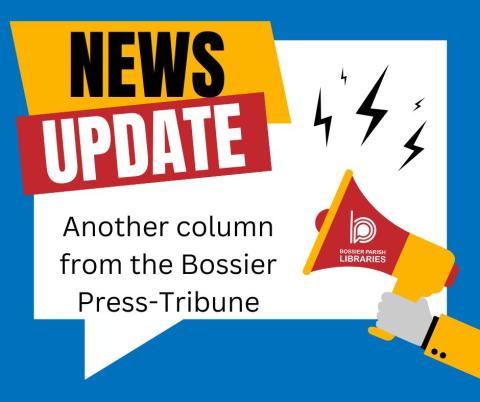
Memorial Day Remembrances - Far Away yet Close at Heart PART 2
For presentations and articles leading up to Memorial Day, I thought I would show fallen soldiers from Bossier Parish being remembered in their hometowns. But some of our soldiers who fought in Europe, and met a tragic end there, stayed overseas. Though it may have been small consolation to their heartbroken families, the American cemeteries and memorials in Europe, most of which commemorate the service and sacrifice of Americans who served in World War I and World War II, are among the most beautiful and meticulously maintained shrines in the world, under the auspices of the American Battle Monuments Commission.
In fact, it was during WWI, with so many dead and so much pressure from the relatives, that the next of kin were given a choice, leave the bodies there or send them home – at Army expense. This choice continued in WWII.
Last week’s article focused on Americans who perished in Europe in WWI and were buried and memorialized at one of the American Cemeteries in Europe, especially a Bossier Parish soldier, Henry Homer Dalrymple. Homer is interred at the Aisne-Marne cemetery in France. This week’s article will focus on Americans who perished in WWII and were buried in Europe, especially focusing on a young man who graduated from Haughton High School, Cassius Clay “Buddy” Brandenburg Jr. whose parents lived in Benton, and whose young widow Cora Ann Foote Brandenburg had been a librarian at the Bossier Parish Libraries before accepting a librarian position at Camp Claiborne.
Buddy Brandenburg graduated from Haughton High School in 1932. He entered Louisiana State Normal College in Natchitoches, La (now Northwestern State) and after graduating in 1936, he took a teaching position at Bossier High School. He taught for one year, then took a variety of jobs, including as a field representative with the Universal Credit Company of Shreveport and at General Motors Acceptance Corporation in Alexandria, Louisiana before volunteering for the Army Air Corps December 27, 1941 at Barksdale Field. (A separate branch of service for air power, the US Air Force, was not established until 1947.)
Buddy was trained as a bombardier in Victorville, California and left for overseas duty on January 1, 1943. Less than two months later, when he was 28 years old, his plane lost altitude at a point near Utrecht, Holland while returning from a mission over Germany, for which he served as lead bombardier. He wasn’t declared “Presumed Dead” by the War Department for another year, after “all possible efforts” had failed to find him.
Buddy Brandenburg’s remains have never been recovered, even though some successful attempts to locate remains of WWII soldiers were done through the 1970’s. His name was carved among the 1,722 names on the Wall of the Missing at the Cambridge American Cemetery in Cambridge, England. Like the other American cemeteries in Europe, this one is breathtakingly beautiful, designed by the famed American landscape architect Frederick Law Olmsted and featuring views of the English countryside that, by law, will always remain farmland.
The History Center has photos of burial services in 1944 at a newly-opened American battlefield cemetery in Margraten, Holland. It is now known as the Netherlands American Cemetery. The site holds the remains of 8,301 servicemen, many of whom died in operations to liberate eastern Holland or advancing into the Rhine area. American flag-draped coffins are visible along with row upon row of white wooden crosses.
In this case, there is no known Bossier connection to any of the men in the caskets, though the photos are from two scrapbooks of photos of Europe, taken during and just after World War II, that belonged to a B-17 pilot in the 305th Bomb group of the Eighth Air Force, now located at Barksdale Air Force Base. We are fortunate to have these rare, up-front views of a ceremony taking place at the time of burial in an overseas American cemetery.
The Netherlands American Cemetery and Memorial in Margraten is the only American military cemetery in the Netherlands. It too is managed under the American Battle Monuments Commission. However, this cemetery has a unique connection to the people of its host country, the Dutch people. Since 1945, members of the local community can adopt a gravesite. They research the life of their adopted service member and put flowers on their grave as a way to honor their sacrifice. Today, the Foundation for Adopting Graves at the American Cemetery in Margraten manages this program.
If you interested in World War topics, please attend one of our monthly World War Tuesdays coffee and conversation program at the History Center. They are on the second Tuesday of the month at 10:30 AM. The next meeting is on Tuesday June 9th, when we will look at the Aleutian campaign, a little-known campaign with a front on American soil. The History Center is located at 2206 Beckett St, Bossier City, LA and is open M-Th 9-8, Fri 9-6, and Sat 9-5. Our phone number is (318) 746-7717 and our email is history-center@bossierlibrary.org
For other fun facts, photos, and videos, be sure to follow us @BPLHistoryCenter on FB, @bplhistorycenter on TikTok.
Images:
- 2nd LT Cassius Clay "Buddy" Brandenburg Jr.
- Sign for the American Cemetery, Margraten, Holland (now called Netherlands American Cemetery) C. 1944. John D. Collins scrapbook collection
- Flag-draped coffins about to be lain to rest in the American Military Cemetery, Margraten Holland (now called Netherlands American Cemetery) C. 1944. John D. Collins scrapbook collection
Article by: Pam Carlisle